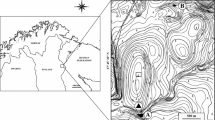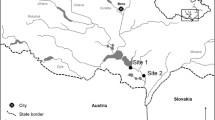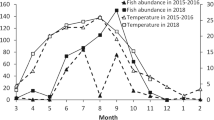Abstract
Brycon gouldingi and B. falcatus were the most abundant and widespread of five species of the genus captured in a sampling study encompassing 5 years (1995–2000) in the upper Rio Tocantins, where the river was impounded by the Serra da Mesa hydroelectric dam. Given that impoundments constitute a disturbance to which species will show demographic and biological responses, we assessed such responses of these two omnivorous fishes, whose genus is regarded as vulnerable to impoundments. Both species increased greatly in numbers during the initial reservoir filling period. Brycon gouldingi had higher abundance values than B. falcatus in all sampling months, except in the pre-impoundment period. Both species showed a significant weight increment relative to body length during the time they remained in the reservoir. No reproductive individuals of B. gouldingi were recorded in the study area, but those few of Brycon falcatus were found in both wet and dry seasons, suggesting a more opportunistic strategy of reproduction. Both species were omnivorous and overlapped broadly in diet. The proportions of dietary items, however, varied in relation to fish size class and water dynamics (lotic versus lentic sites). Terrestrial arthropods composed a larger proportion of the diet of smaller-sized individuals and those from lentic sites, whereas seeds and fruits contributed more to the diet of both larger-sized individuals and those from lotic environments. Except for fish and aquatic heteropterans, which were consumed mainly in the reservoir, all other food items were allochthonous, indicating the dependence of these two species of Brycon on the terrestrial environment. The two species responded similarly to the alterations imposed by the impoundment of the upper Tocantins, although reproduction/recruitment pattern was slightly different between species. As observed in other regions of Brazil, impoundments and deforestation appear to produce negative cumulative effects on species of Brycon. These impacts call for greater efforts to conserve and manage members of this diverse and widespread genus.


Similar content being viewed by others
References
Agostinho, A. A., H. F. Julio & M. M. Petrere Jr, 1994. Itaipu Reservoir (Brazil): impacts of the impoundment on the fish fauna and fisheries. In Cowx, I. G. (ed.), Rehabilitation of Freshwater Fisheries. University of Hull Fishing New Books, Hull.
Agostinho, A. A., A. E. A. M. Vazzoler & S. M. Thomaz, 1995. The high river Paraná basin: limnological and ichthyological aspects. In Tundisi, J. G., C. E. M. Bicudo & T. Matsumura-Tundisi (eds), Limnology in Brazil. ABC/SBL, Rio de Janeiro.
Agostinho, A. A., L. E. Miranda, L. M. Bini, L. C. Gomes, S. M. Thomaz & H. I. Suzuki, 1999. Patterns of colonization in Neotropical reservoirs, and prognoses on aging. In Tundisi, J. G. & M. Straškraba (eds), Theoretical Reservoir Ecology and its Applications. International Institute of Ecology, São Carlos, Brazil.
Agostinho, A. A., E. Zaniboni-Filho & F. C. T. Lima, 2008. Brycon orbygnianus. In Machado A., G. Drummond & C. Martins (eds), Livro vermelho da fauna ameaçada do Brasil. Biodiversitas, Belo Horizonte: 54–56.
Albrecht, M. P. & E. P. Caramaschi, 2003. Feeding ecology of Leporinus friderici (Teleostei, Anostomidae) in the upper Tocantins river, central Brazil, before and after installation of a hydroelectric plant. Studies on Neotropical Fauna and Environment 38: 33–40.
Anderson, R. O. & R. M. Neumann, 1996. Length, weight, and associated structural indices. In Murphy, B. R. & D. W. Willis (eds), Fisheries Techniques. American Fisheries Society, Bethesda.
Banack, S. A., M. H. Horn & A. Gawlicka, 2002. Disperser- vs. establishment-limited distribution of a riparian fig tree (Ficus insipida) in a Costa Rican tropical rain forest. Biotropica 34: 232–243.
Barthem, B. R., M. C. L. B. Ribeiro & M. Petrere, 1991. Life strategies of some long-distance migratory catfish in relation to hydroeletric dams in the Amazon Basin. Biological Conservation 55: 339–345.
Begossi, A. & F. M. S. Braga, 1992. Food taboos and folk medicine among fishermen from the Tocantins river (Brazil). Amazoniana XII(1): 101–118.
Benedito-Cecílio, E., A. L. Pereira & C. M. Saguragui, 2004. Effect of size on the energy acquired in species of the fish from a neotropical reservoir, Brazil. Environmental Biology of Fishes 71: 313–320.
Bolnick, D. I., R. Svanbäck, J. A. Fordyce, L. H. Yang, J. M. Davis, C. D. Hulsey & M. L. Forister, 2003. The ecology of individuals: incidence and implications of individual specialization. The American Naturalist 161: 1–28.
Borges, G. A., 1986. Ecologia de três espécies do gênero Brycon Müller & Troschel, 1844 (Pisces-Characidae), no rio Negro-Amazonas, com ênfase na caracterização taxonômica e alimentação. Master Thesis, Instituto Nacional de Pesquisas da Amazônia, Manaus, Brazil.
Burcham, J., 1988. Fish communities and environmental characteristics of two lowland streams in Costa Rica. Revista de Biología Tropical 36: 273–285.
Cânepa, J. R., 1988. Comportamento alimentario del “sábalo cola roja” Brycon erythropterum (Pisces: Characidae). Boletin de Lima 59: 23–27.
Carolsfeld, J., B. Harvey, C. Ross & A. Baer, 2003. Migratory Fishes of South America. IDRC and the World Bank, Victoria.
De Filippo, R., E. L. Gomes, J. Lenz-César, C. B. P. Soares & C. F. S. Menezes, 1999. As alterações da qualidade da água durante o enchimento do reservatório de UHE Serra da Mesa—GO. In Henry, R. (ed.), Ecologia de reservatórios: estrutura, função e aspectos sociais. Fapesp/Fundibio, Botucatu, Brazil.
Drewe, K. E., M. H. Horn, K. A. Dickson & A. Gawlicka, 2004. Insectivore to frugivore: ontogenetic changes in gut morphology and digestive enzyme activity in the characid fish Brycon guatemalensis from Costa Rican rain forest streams. Journal of Fish Biology 64: 890–902.
Gerking, S. D., 1994. Feeding Ecology of Fish. Academic Press, San Diego.
Godoy, M. P., 1975. Peixes do Brasil: subordem Characoidei, bacia do Rio Mogi Guassu. Franciscana, Piracicaba.
Goulding, M., 1980. The fishes and the forest—explorations in Amazonian natural history. University of California Press, Berkeley.
Greathouse, E. F., C. M. Pringle, W. D. McDowell & J. G. Holmquist, 2006. Indirect upstream effects of dams: consequences of migratory consumer extirpation in Puerto Rico. Ecological Applications 16: 339–352.
Holmquist, J. G., J. M. Schmidt-Gengenbach & B. B. Yoshioka, 1998. High dams and marine-freshwater linkages: effects on native and introduced fauna in the Caribbean. Conservation Biology 12: 621–630.
Horn, M. H., 1989. Biology of marine herbivorous fishes. Oceanography and Marine Biology Annual Review 27: 167–272.
Horn, M. H., 1997. Evidence for dispersal of fig seeds by the fruit-eating characid fish Brycon guatemalensis Regan in a Costa Rican tropical rain forest. Oecologia 109: 259–264.
Jager, H. I., J. A. Chandler, K. B. Leplan & W. V. Winkle, 2001. A theoretical study of river fragmentation by dams and its effects on white sturgeon populations. Environmental Biology of Fishes 60: 347–361.
Kramer, D. L. & M. J. Bryant, 1995. Intestine length in the fishes of a tropical stream: 2. Relationships to diet—the long and short of a convoluted issue. Environmental Biology of Fishes 42: 129–141.
Krebs, C. J., 1989. Ecological Methodology. HarperCollins Publishers, New York.
Kubitski, K. & A. Ziburski, 1994. Seed dispersal in foodplain forests of Amazonia. Biotropica 26: 30–43.
Lima, F. C. T., 2003. Subfamily Bryconinae. In Reis, R. E., S. O. Kullander & C. J. Ferraris (eds), Check List of the Freshwater Fishes of South and Central America. EDIPUCRS, Porto Alegre, Brazil.
Lima, F. C. T., 2004. Brycon gouldingi, a new species from the rio Tocantins drainage, Brazil (Ostariophysi: Characiformes: Characidae), with a key to the species in the basin. Ichthyological Exploration of Freshwaters 15: 279–287.
Lima, F. C. T. & R. M. C. Castro, 2000. Brycon vermelha, a new species of characid fish from the Rio Mucuri, a coastal river of eastern Brazil (Ostariophysi: Characiformes). Ichthyological Exploration of Freshwaters 11: 155–162.
Lima, F. C. T., M. P. Albrecht, C. S. Pavanelli & V. Vono, 2008. Threatened fishes of the world: Brycon nattereri Günther, 1864 (Characidae). Environmental Biology of Fishes 83: 207–208.
Lowe-McConnell, R. H., 1964. The fishes of the Rupununi savanna district of British Guiana, Pt. 1. Groupings of fish species and effects of seasonal cycles on the fish. Zoological Journal of the Linnean Society 45: 103–144.
Lowe-McConnell, R. H., 1987. Ecological Studies in Tropical Fish Communities. Cambridge University Press, Cambridge.
Magurran, A. E., 1988. Ecological Diversity and its Measurements. Princeton University Press, Princeton.
Margalef, R., 1983. Limnología. Editora Omega, Barcelona.
Matthews, W. J., 1998. Patterns in Freshwater Fish Ecology. Chapman & Hall, Norwell.
Menezes, N. A., 1969. The food of Brycon and three closely related genera of the tribe Acestrorhynchini. Papéis Avulsos de Zoologia 22: 217–223.
Mérona, B., G. M. Santos & R. G. Almeida, 2001. Short term effects of Tucuruí dam (Amazonia, Brazil) on the trophic organization of fish communities. Environmental Biology of Fishes 60: 375–392.
Mérona, B., R. Vigouroux & V. Horeau, 2003. Changes in food resources and their utilization by fish assemblages in a large tropical reservoir in South America (Petit-Saut Dam, French Guiana). Acta Oecologica 24: 147–156.
Novaes, J. L. C., E. P. Caramaschi & K. O. Winemiller, 2004. Feeding of Cichla monoculus Spix, 1829 (Teleostei: Cichlidae) during and after reservoir formation in the Tocantins river, Central Brazil. Acta Limnologica Brasiliensis 16: 41–49.
Peterson, C. C. & P. McIntyre, 1998. Ontogenetic diet shifts in Roeboides affinis with morphological comparisons. Environmental Biology of Fishes 53: 105–110.
Petrere, M. & M. C. L. B. Ribeiro, 1994. The impact of a large tropical hydroelectric dam: the case of Tucuruí in the middle river Tocantins. Acta Limnologica Brasiliensis 5: 123–133.
Pillar, V. P., 1999. MULTIV, software para análise multivariada e testes de aleatorização. Departamento de Ecologia, Universidade Federal do Rio Grande do Sul, Porto Alegre, Brazil.
Pillar, V. P. & L. Orlóci, 1996. On randomization testing in vegetation science: multifactor comparisons of relevé groups. Journal of Vegetation Science 7: 585–592.
Power, M. E., 2001. Prey exchange between a stream and its forested watershed elevates predator densities in both habitats. Proceedings of the National Academy of Science 98: 14–15.
Ribeiro, M. C. L. B., M. Petrere & A. A. Juras, 1995. Ecological integrity and fisheries ecology of the Araguaia–Tocantins basin, Brazil. Regulated Rivers 11: 325–350.
Santos, G., E. Ferreira & J. Zuanon, 2006. Peixes comerciais de Manaus. Pró-Várzea, Ibama, Manaus.
Sioli, H., 1980. Amazônia: fundamentos da ecologia da maior região de florestas tropicais. Editora Vozes, Petrópolis, Brazil.
StatSoft, Inc., 2001. STATISTICA (data analysis software system), version 6.0. www.statsoft.com.
Svanbäck, R. & L. Persson, 2004. Individual diet specialization, niche width an population dynamics: implications for trophic polymorphisms. Journal of Animal Ecology 73: 973–982.
Useche, C., P. Cala & H. Hurtado, 1993. Sobre la ecología de Brycon siebenthalae y Mylossoma duriventris (Characidae) en el río Cafre, Orinoquia. Caldasia 17: 341–352.
Vázquez, D. P. & D. Simberloff, 2002. Ecological specialization and susceptibility to disturbance: conjectures and refutations. The American Naturalist 159: 606–623.
Vazzoler, A. E. A. M., 1996. Biologia reprodutiva de peixes Teleósteos: teoria e prática. EDUEM, Maringá, Brazil.
Winemiller, K. O., 1989a. Patterns of variation in life history among South American fishes in seasonal environments. Oecologia 81: 225–241.
Winemiller, K. O., 1989b. Ontogenetic diet shifts and resource partitioning among piscivorous fishes in the Venezuelan Ilanos. Environmental Biology of Fishes 26: 177–199.
Winemiller, K. O., 1990. Spatial and temporal variation in tropical fish trophic networks. Ecological Monographs 60: 331–367.
Winemiller, K. O. & E. R. Pianka, 1990. Organization in natural assemblages of desert lizards and tropical fishes. Ecological Monographs 60: 27–55.
Zaniboni-Filho, E. & E. K. Resende, 1988. Anatomia de gônadas, escala de maturidade e tipo de desova da matrinchã, Brycon cephalus (Günther, 1869) (Teleostei: Characidae). Revista Brasileira de Biologia 48: 833–844.
Acknowledgments
Funding for this study was obtained by the contract UFRJ/BIORIO/Furnas—Serra da Mesa Energia S.A. and later by UFRJ/FECD/Furnas—CPFL. The first author thanks CNPq (SWE no. 200277/2004-9 and PDJ no. 151148/2005-8) and FAPERJ for the grants. EPC thanks CNPq for the PQ stipend (proc. no. 309506/2003-4). MHH thanks CSUF for the mini-grant that supported his participation. The authors are also grateful to other participants of the project for obtaining fish and field data, to V. P. Pillar for providing the MULTIV software for the multivariate analyses, and to F. C. T. Lima for fruitful discussions and a critical review of the manuscript.
Author information
Authors and Affiliations
Corresponding author
Additional information
Handling editor: S.M. Thomaz
Rights and permissions
About this article
Cite this article
Albrecht, M.P., Caramaschi, É.P. & Horn, M.H. Population responses of two omnivorous fish species to impoundment of a Brazilian tropical river. Hydrobiologia 627, 181–193 (2009). https://doi.org/10.1007/s10750-009-9727-7
Received:
Revised:
Accepted:
Published:
Issue Date:
DOI: https://doi.org/10.1007/s10750-009-9727-7




